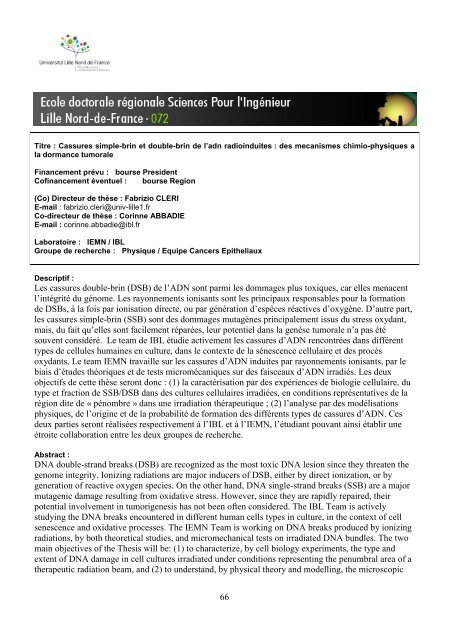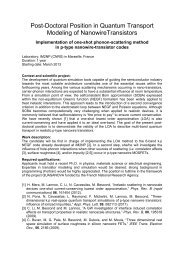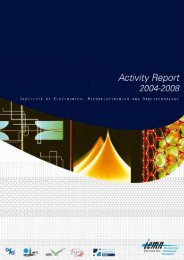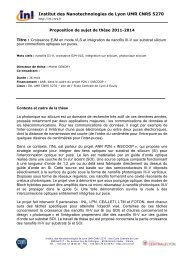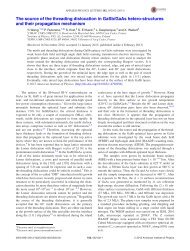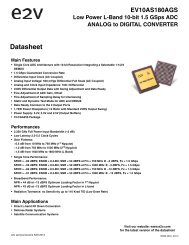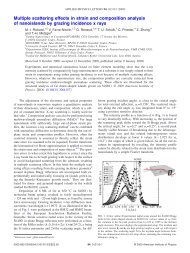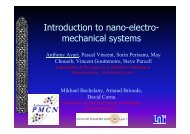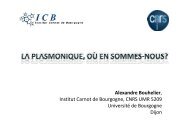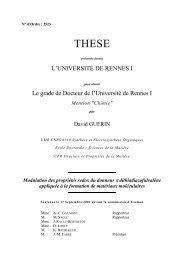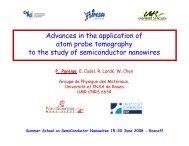Sujet de Doctorats 2013 - IEMN
Sujet de Doctorats 2013 - IEMN
Sujet de Doctorats 2013 - IEMN
- No tags were found...
You also want an ePaper? Increase the reach of your titles
YUMPU automatically turns print PDFs into web optimized ePapers that Google loves.
Titre : Cassures simple-brin et double-brin <strong>de</strong> l’adn radioinduites : <strong>de</strong>s mecanismes chimio-physiques ala dormance tumoraleFinancement prévu : bourse Presi<strong>de</strong>ntCofinancement éventuel : bourse Region(Co) Directeur <strong>de</strong> thèse : Fabrizio CLERIE-mail : fabrizio.cleri@univ-lille1.frCo-directeur <strong>de</strong> thèse : Corinne ABBADIEE-mail : corinne.abbadie@ibl.frLaboratoire : <strong>IEMN</strong> / IBLGroupe <strong>de</strong> recherche : Physique / Equipe Cancers EpitheliauxDescriptif :Les cassures double-brin (DSB) <strong>de</strong> l’ADN sont parmi les dommages plus toxiques, car elles menacentl’intégrité du génome. Les rayonnements ionisants sont les principaux responsables pour la formation<strong>de</strong> DSBs, à la fois par ionisation directe, ou par génération d’espèces réactives d’oxygène. D’autre part,les cassures simple-brin (SSB) sont <strong>de</strong>s dommages mutagènes principalement issus du stress oxydant,mais, du fait qu’elles sont facilement réparées, leur potentiel dans la genèse tumorale n’a pas étésouvent considéré. Le team <strong>de</strong> IBL étudie activement les cassures d’ADN rencontrées dans différenttypes <strong>de</strong> cellules humaines en culture, dans le contexte <strong>de</strong> la sénescence cellulaire et <strong>de</strong>s procèsoxydants. Le team <strong>IEMN</strong> travaille sur les cassures d’ADN induites par rayonnements ionisants, par lebiais d’étu<strong>de</strong>s théoriques et <strong>de</strong> tests micromécaniques sur <strong>de</strong>s faisceaux d’ADN irradiés. Les <strong>de</strong>uxobjectifs <strong>de</strong> cette thèse seront donc : (1) la caractérisation par <strong>de</strong>s expériences <strong>de</strong> biologie cellulaire, dutype et fraction <strong>de</strong> SSB/DSB dans <strong>de</strong>s cultures cellulaires irradiées, en conditions représentatives <strong>de</strong> larégion dite <strong>de</strong> « pénombre » dans une irradiation thérapeutique ; (2) l’analyse par <strong>de</strong>s modélisationsphysiques, <strong>de</strong> l’origine et <strong>de</strong> la probabilité <strong>de</strong> formation <strong>de</strong>s différents types <strong>de</strong> cassures d’ADN. Ces<strong>de</strong>ux parties seront réalisées respectivement à l’IBL et à l’<strong>IEMN</strong>, l’étudiant pouvant ainsi établir uneétroite collaboration entre les <strong>de</strong>ux groupes <strong>de</strong> recherche.Abstract :DNA double-strand breaks (DSB) are recognized as the most toxic DNA lesion since they threaten thegenome integrity. Ionizing radiations are major inducers of DSB, either by direct ionization, or bygeneration of reactive oxygen species. On the other hand, DNA single-strand breaks (SSB) are a majormutagenic damage resulting from oxidative stress. However, since they are rapidly repaired, theirpotential involvement in tumorigenesis has not been often consi<strong>de</strong>red. The IBL Team is activelystudying the DNA breaks encountered in different human cells types in culture, in the context of cellsenescence and oxidative processes. The <strong>IEMN</strong> Team is working on DNA breaks produced by ionizingradiations, by both theoretical studies, and micromechanical tests on irradiated DNA bundles. The twomain objectives of the Thesis will be: (1) to characterize, by cell biology experiments, the type an<strong>de</strong>xtent of DNA damage in cell cultures irradiated un<strong>de</strong>r conditions representing the penumbral area of atherapeutic radiation beam, and (2) to un<strong>de</strong>rstand, by physical theory and mo<strong>de</strong>lling, the microscopic66


